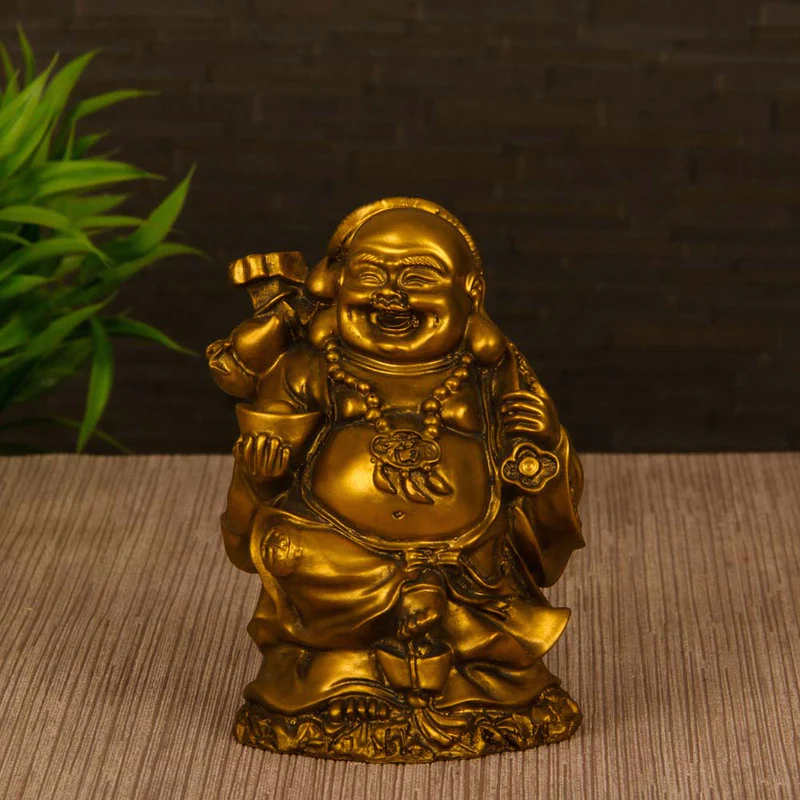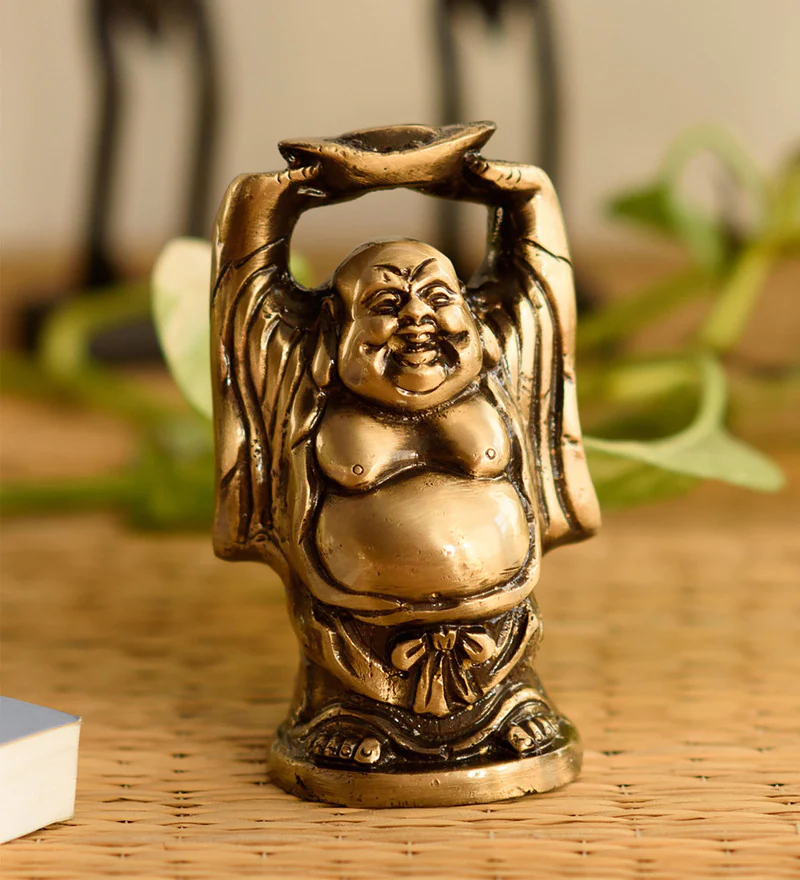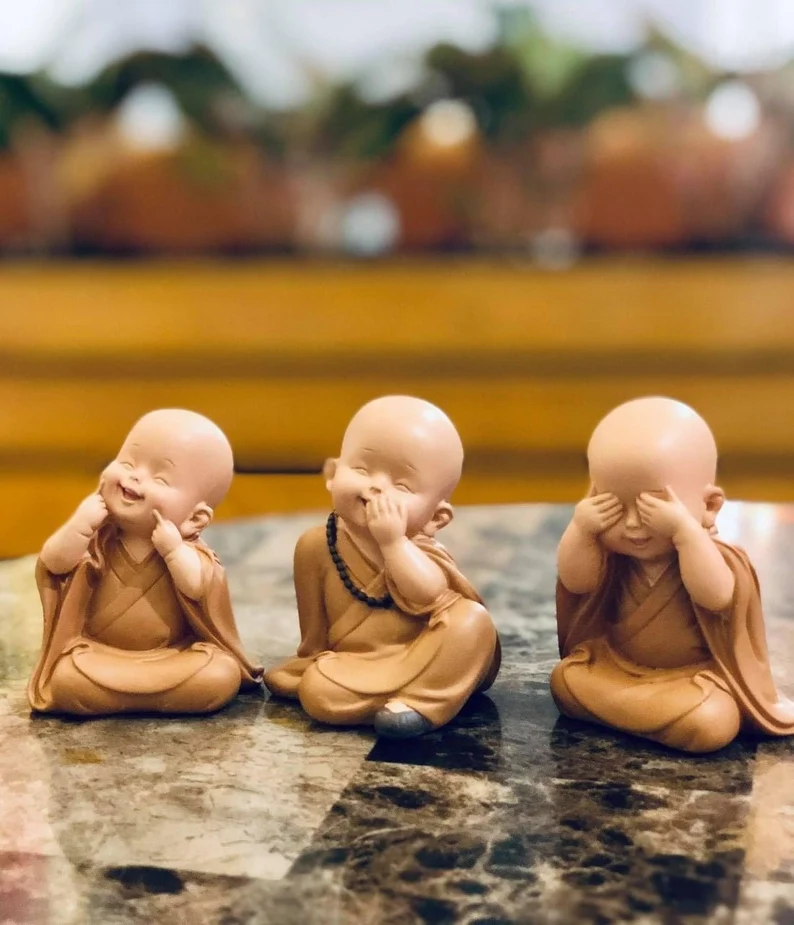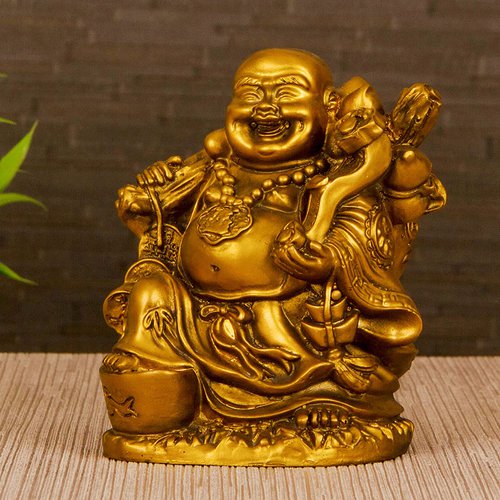The Laughing Buddha statue is perhaps the most loved of artefacts used for home decor. Vastu and Feng Shui believers believe that the Laughing Buddha image & statue brings prosperity, joy, and contentment. Also, the Laughing Buddha image has become an essential interior decoration piece and a gift symbolizing good vibes and money, universally.
However, the contemporary use of this statue has expanded from just gifts to using Laughing Buddha images on furnishings, wall art, indoor planters, furniture decor, and more. The Budai statue in various postures signifies specific things. Hence it is selected by believers for fulfilling wishes.
Scroll on to learn the meaning, story, and tips on placing the Laughing Buddha statue for positive energies, luck, health, and money, and select an attractive Laughing Buddha statue as a gift. We have provided some shopping options in this article to help you choose the most suitable figurines for your living space aesthetics. So, read along!
Contents
- 1 What is the story behind Laughing Buddha?
- 2 Types of Laughing Buddha statues
- 3 Tips for placing Budai statues
- 4 Our top Laughing Buddha statue recommendations (Buy here)
- 4.1 Wall Mantra Golden Crafted Decorative Laughing Buddha Figurine
- 4.2 The White Decor Polyresin Premium Fengshui Laughing Buddha Figurine
- 4.3 E Craft India Brown Brass Finish Laughing Buddha
- 4.4 Buddhadecor Beige Color Statue & Ornament
- 4.5 Petrichor Laughing Buddha on Frog
- 4.6 Decorfur Red Maitreya Laughing Buddha
- 4.7 ViviCorner 2020 Laughing Buddha Statue Set 3
- 4.8 The White Ink Decor Laughing Buddha Figurine
- 4.9 Tied Ribbons Gold Toned Decorative Laughing Buddha Showpiece
- 4.10 Coral Caribe Healing Lucky Buddha Figurine
- 5 Conclusion
What is the story behind Laughing Buddha?
Traditional Chinese beliefs state Hotei or Pu-Tai or Budai was an eccentric Chinese monk who lived during the later Liang dynasty (907-923 AD). A native of Fenghua, his Buddhist name was Qieci (Chinese: Pinyin). He is considered a Buddha or ‘Bodhisattva’, usually Maitreya or the future Buddha.
His name means cloth sack and refers to the bag he carries as he wanders. His jolly nature and eccentric lifestyle distinguish him from most Buddhist masters hence his nickname in Chinese, the Laughing Buddha. People believe that if one rubs Budai’s great belly, it brings wealth, good luck, and prosperity.
In the Chan Buddhist pantheon, Budai is a wandering vagabond and a mendicant priest who brought abundance, fortune, and joy to all with his mystical cloth sack bag. It is a universal belief placing Laughing Buddha images or Laughing Buddha statues in the home brings positive energy.
| Also see: Vastu Shastra: Design principles & tips to invite positivity in home |
Types of Laughing Buddha statues
Buddha statue with children

Image Source: Amazon
It is the most innocent form of Laughing Buddha encircled by five children. Beliefs say that it encourages your child’s immunity & health and improves fertility in couples.
Buddha statue with gold coins

Image Source: Taajoo.com
A sought-after form, the Laughing Buddha statue invites success, wealth, and prosperity if placed in workplaces. It is the ideal Laughing Buddha for money.
| Also see: 49+ home decor ideas for a trendy & timeless design update |
Laughing Buddha statue with a sack

Image Source: Ubuy India
A Budai statue in this pose signifies bundling all your problems into the sack away from your home or office. Consequently, it brings success and wealth to you and your family.
Budai statue with a fan
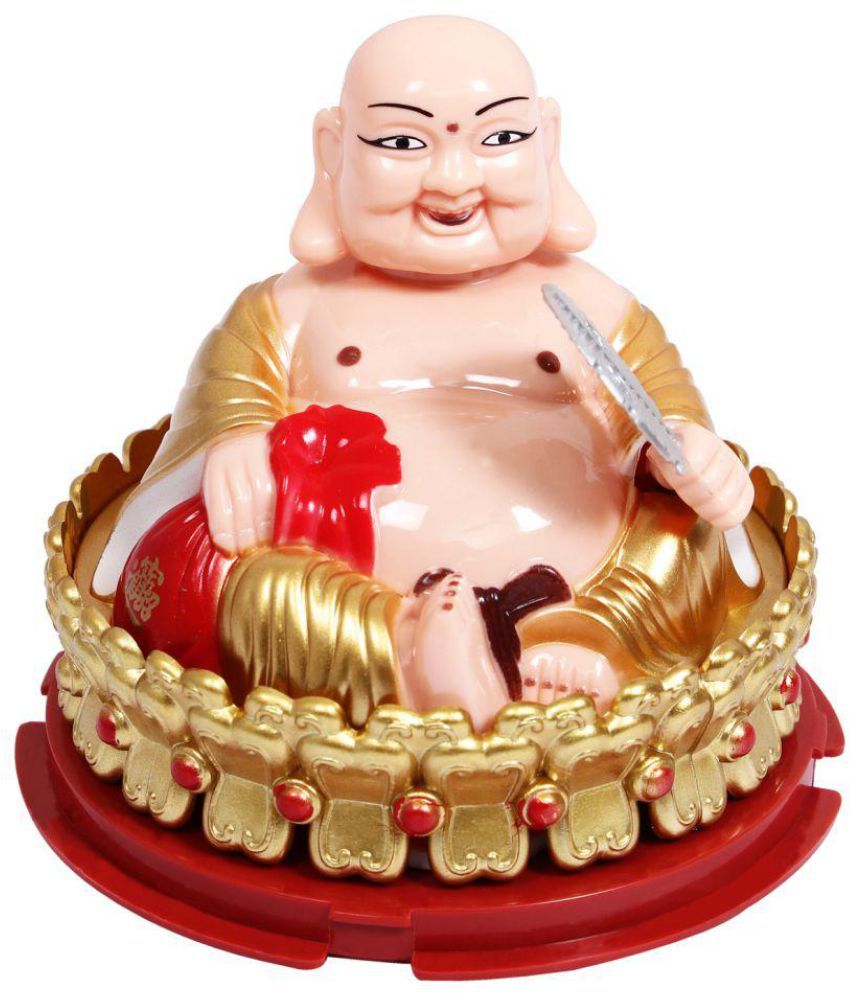
Image Source: Snapdeal
The statue gives strength and positivity to overcome any issues. It also fans away problems and welcomes joy into your home in the form of guests.
Budai statue holding pearls
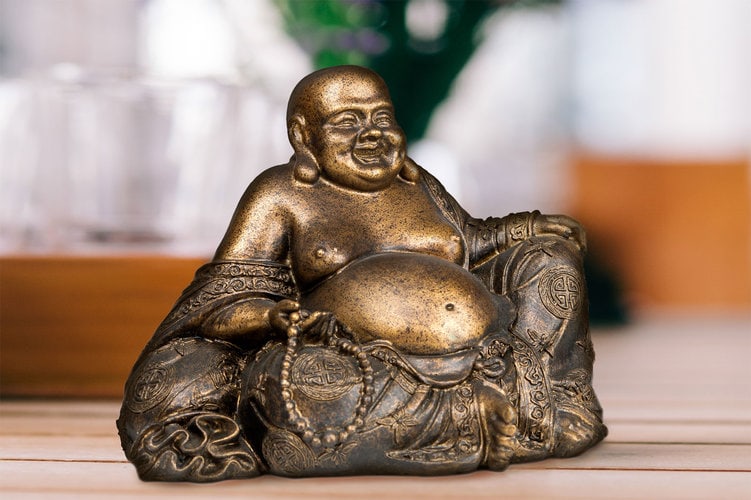
Image Source: Love to know
This statue holding pearls symbolizes meditation bringing prosperity. Some interpretations say it signifies pearls of wisdom or peaches or apricots, representing health.
| Also see: Ganesha Murti & photos: Vastu-approved decor digest (Buy idols!) |
Buddha with a bowl

Image Source: Snapdeal
The bowl associated with monkhood depicts simplicity, humility, values, and the pursuit of enlightenment.
Buddha in resting posture

Image Source: museumize.com
The statue in the reclining posture denotes happiness, tranquillity, and a balanced mind.
Budai with a Wo Lu

Image Source: Snapdeal
The smiling Budai holding a Wo Lu gourd shaped like an hourglass promotes healing, long life, and good health.
Buddha with both hands raised

Image Source: Pinterest
Signifying complete release from material possessions, this Laughing Buddha, with both hands raised over his head, either carries a bowl or coins in his palms. Beliefs say it depicts victory in financial matters or personal obstacles and brings blessings from the heavens.
Tips for placing Budai statues
Vastu Shastra is one of the most ancient sciences for architecture layouts and designing rules for positive energy. It defines how the science behind dwelling develops your lifestyle for the better. On the other hand, Feng Shui is an ancient Chinese art that involves balancing the cosmic element of water & wind in a system to achieve harmony with the cosmic forces and positioning the surroundings in tune with the harmony principles of Chi. However, both Vastu and Feng Shui are the results of scientific observations aiming to add harmony, prosperity, and happiness to one’s home and life. So let’s explore some Vastu and Feng Shui tips related to Laughing Buddha placement.
Vastu tips for placing Laughing Buddha statues
- The best place for the statue is in the southeast, east, or northeast direction, preferably opposite the main entrance or facing toward the house.
- Vastu advises placing the Buddha statue in a clean and clutter-free area in the northeast direction.
- The east, the direction of the rising sun, and the place of good fortune are best to place the Laughing Monk.
- However, never keep a Budai statue in the kitchen, bathroom or toilet.
- Take care to place the statue at eye level and never on the floor.
Feng Shui tips for placing Laughing Buddha statues
- The Feng Shui belief says placing a Laughing Buddha for money in the direction of personal Chi at home will enhance wealth and overall well-being.
- Feng Shui advises placing it in a manner that the Statue faces the inflowing Chi from the entrance and not with its back to it.
- Placing a statue in the children’s room is considered good. Ideally, placing a statue at their study table encourages good concentration.
- A Budai statue on the work desk at home or office helps in career prospects and good professional relations.
- Feng Shui suggests that keeping a stone Laughing Buddha statue in the garden brings good energy.
Our top Laughing Buddha statue recommendations (Buy here)
Wall Mantra Golden Crafted Decorative Laughing Buddha Figurine
| B U Y H E R E |
The White Decor Polyresin Premium Fengshui Laughing Buddha Figurine
Petrichor Laughing Buddha on Frog

| B U Y H E R E |
Decorfur Red Maitreya Laughing Buddha
| B U Y H E R E |
ViviCorner 2020 Laughing Buddha Statue Set 3
| B U Y H E R E |
The White Ink Decor Laughing Buddha Figurine
| B U Y H E R E |
Tied Ribbons Gold Toned Decorative Laughing Buddha Showpiece
| B U Y H E R E |
Coral Caribe Healing Lucky Buddha Figurine
| B U Y H E R E |
Conclusion
This unique statue, the most loved symbol of prosperity, contentment, money, and happiness, is frequently placed in homes and offices to spark positivity. Popular beliefs say placing several of these figurines in different forms around the house fills the space with positive energy and happiness. Ideally, concepts of Vastu Shastra and Feng Shui applied correctly, help balance the energies in our home and life.
These ancient concepts show us the proper placement of the Buddha statue or Budai image. While going through this article, you have discovered interesting facts about Budai, its origins, beliefs, stories, and practical tips for filling your living space with vibrant, positive energy.
So, now you know every important detail for buying any Laughing Buddha statue or images for luck and money, as a gift for someone, or for placing in your home. If you are looking for Laughing Buddha gift items, you can browse the above-mentioned top buying options and give your house an aesthetically positive vibe.
*The featured image used in this article is from Sketchfab.com











